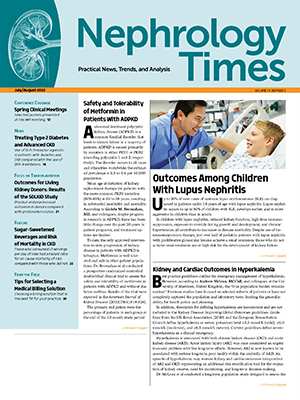
Up to 20% of new cases of systemic lupus erythematosus (SLE) are diagnosed in patients under 18 years of age with lupus nephritis. Lupus nephritis occurs in up to 80% of children with SLE, develops earlier, and is more aggressive in children than in adults.
In children with lupus nephritis, reduced kidney function, high-dose immunosuppression, exposure to steroids during growth and development, and chronic hypertension all contribute to increases in disease morbidity. Despite use of immunosuppression therapy, just over half of pediatric patients with lupus nephritis with proliferative glomerular lesions achieve a renal remission; those who do not achieve renal remission are at high risk for the development of kidney failure.
Data from the US Renal Data System show that the risk of death in patients with kidney failure secondary to lupus nephritis is significantly increased compared with patients with kidney failure from all other causes. Further, the risk of death in Black children with lupus nephritis on maintenance hemodialysis is twice that of Black children on maintenance hemodialysis due to kidney failure from other causes.
Heather Wasik, MD, MHS, and colleagues conducted a retrospective cohort study to compare outcomes among children with lupus nephritis on dialysis with children with non-lupus glomerular disease; the study also examined the risk factors for adverse outcomes among pediatric patients with lupus nephritis on dialysis. Results were reported in the American Journal of Kidney Diseases [2022;79(5):626-634].
Eligible study participants were children and adolescents 6 to 20 years of age enrolled in the North American Pediatric Renal Trials and Collaborative Studies (NAPRTCS) registry with lupus nephritis (n=231) and children and adolescents with non-lupus glomerular disease (n=1726) who initiated maintenance dialysis from 1991 to 2018. The outcomes of interest were hospitalization, mortality, and time to transplant.
Hospitalizations were compared using contingency tables; rates of transplantation and death in children with lupus nephritis were compared with those with non-lupus glomerular disease with multivariable cause-specific hazards models. Using data from children with lupus nephritis, multivariable logistic regression models were fit to evaluate the risk factors for hospitalization; multivariable Cox regression models were fit to evaluate factors associated with kidney transplantation.
Patients in the group with lupus nephritis were older (mean age, 15.3 years vs 13.9 years; P<.001), more likely to be female (78.8% vs 46.8%; P<.001), more likely to be Black (51.5% vs 34.0%; P<.001), more likely to have hemodialysis as their index dialysis modality (61.5% vs 43.8%; P<.001), had a lower mean hematocrit (29.7% vs 31.0%; P=.01), and were more likely to be taking a greater number of medications (47.4% vs 26.4% took ≥6 medications; P<.001) compared with patients in the non-lupus glomerular disease group. The two groups were similar in the proportion of patients with anemia and hypertension, mean height, weight, and body mass index z scores, or dialysis initiation era.
In the total study cohort, median follow-up time was 1.23 years; in the lupus nephritis group it was 1.26 years and in the comparison group it was 1.22 years. The primary reason for loss to follow-up was lack of continued data entry in both groups. Loss to follow-up occurred in 96 patients in the lupus nephritis group and 515 patients in the comparison group. Other reasons for loss to follow-up prior to death or kidney transplantation were return of native kidney function (24 patients in the lupus nephritis group and 21 in the comparison group), administrative censoring (2 in the lupus nephritis group and 16 in the comparison group), and transfer of care to a non-NAPRTCS site (1 patient in the comparison group).
Patients in the lupus nephritis group were more likely to be hospitalized within 6 months (49.2% vs 35.1%; P<.001) and within 12 months (63.3% vs 48.6%; P<.001) of initiation of dialysis. Of the patients who were hospitalized within the 12 months after dialysis initiation, the median number of hospitalization days was 9.5 in the lupus nephritis group versus 7 days in the comparison group (P=.004). Reasons for hospitalization included infection, access complications, hypertension, and other cardiovascular disease.
The cumulative incidence of kidney transplantation following initiation of dialysis was significantly lower in patients in the lupus nephritis group than in the comparison group. Even after adjustment for age, race, sex, index dialysis modality, the presence of hypertension, the presence of anemia, and dialysis initiation era, the hazard of kidney transplantation was statistically significantly lower in the lupus nephritis group than in the comparison group (adjusted hazard ratio [aHR], 0.36; 95% CI, 0.23-0.57; P<.001) and in years 1 to 3 from dialysis initiation (aHR, 0.73; 95% CI, 0.54-0.98; P=.04). There were no statistically significant differences between the two groups in the hazard ratio comparison (aHR, 0.96; 95% CI, 0.55-1.66; P=.9) after more than 3 years from dialysis initiation.
The cumulative incidence of death following initiation of dialysis was nominally higher in patients in the lupus nephritis group than in the comparison group, but the difference did not reach statistical significance. There was no statistically significant difference in the hazard of death following initiation of dialysis after adjustment for patient age, race, sex, index dialysis modality, the presence of hypertension and anemia, and dialysis initiation era (aHR, 1.21; 95% CI, 0.47-3.11; P=.7). There were only six deaths in the lupus nephritis group and 25 in the comparison group. In both groups, the leading cause of death was cardiopulmonary disease (33% of deaths in the lupus nephritis group and 28% in the comparison group).
Anemia was associated with hospitalization following initiation of dialysis (adjusted odds ratio, 4.44; 95% CI, 1.44-13.66; P=.009). There was an association between non-White race and a lower rate of kidney transplantation (aHR, 0.47; 95% CI, 0.27-0.82; P=.01). There was no association between lupus nephritis and death while on dialysis (aHR, 1.21; 95% CI, 0.47-3.11; P=.7).
The researchers cited the lack of data on lupus disease activity and medication doses, as well as limited data on medication use in the NAPRTCS registry as limitations to the study findings.
In conclusion, the authors said, “Children with lupus nephritis who require dialysis are at high risk of adverse outcomes, including hospitalization and death in kidney transplantation. Further study must be done to identify the risk factors for adverse outcomes and to assess targeted interventions to decrease morbidity and mortality in this vulnerable population.”
Takeaway Points
- Researchers reported results of a study comparing outcomes among children with lupus nephritis with those among children with non-lupus glomerular disease.
- Children with lupus were more likely to be hospitalized and had a lower rate of kidney transplantation.
- There was no significant difference between the two groups in cumulative incidence of death after initiation of dialysis.







 © 2025 Mashup Media, LLC, a Formedics Property. All Rights Reserved.
© 2025 Mashup Media, LLC, a Formedics Property. All Rights Reserved.